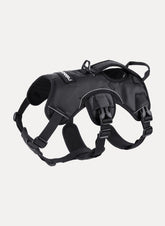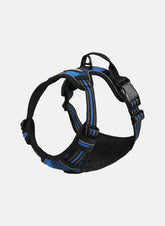Dog Harness vs Collar: Which is Safer?
As a dog parent, your concern about your dog's neck safety is valid and we’re here to help! Here’s a brief answer about dog harness vs collar:
Collars are a traditional option that dog owners have been using for hundreds of years while harnesses are comparatively new. Although both can be helpful, when it comes to safety Harness is the winner. A harness doesn’t pose any harm to the neck like a collar which can break or cause suffocation for the dog (if not used properly).
To explain better, we’ll discuss what vets think of collars and harnesses and explain their pros and cons in detail. By the end of this guide, you’ll be able to decide whether you should use a collar or a harness. So let’s get started!
Do Vets Recommend Collars or Harnesses?
Most vets generally recommend harnesses because of their safety and comfort. However, it’s important to note that when we’re discussing the safety of harnesses it doesn’t mean collars are absolutely dangerous.
It only means there’s a chance that something bad might happen in case your dog pulls. As Dr Em explained:
If your dog is pulling while they’re on a collar it can cause serious damage. Dogs have veins, arteries, and many other delicate structures in their neck. The veins supply oxygen to the brain. If they’re affected your dog may feel suffocation. Besides that, the pressure on the neck can increase the pressure on the eyeballs causing pain. This is why a harness is considered a safe option.
You can check the images below to understand how the harness is attached to the body (chest and shoulder). While the collar is only attached to the neck.
Harnesses: Pros and Cons
Here are the pros and cons of using the harness for dogs.
Pros of Using Harness for Dogs
- Safe for dogs: Harnesses are completely safe for dogs of all ages. The neck of your dog will be safe, there will be no choking, suffocation, or any neck injury. It’s because harnesses are attached to the body and distribute the pressure evenly across the chest and shoulder not only to the neck.
- Provides comfort: One of the biggest features of using a harness is it provides comfort. Your dog won’t feel any pain or pressure on the neck making them feel secure and happy.
- Good for training: Harnesses are more suitable to use during training than the collar. With a harness, you’ll have better control over dog movement (in a safe way), making it easier to teach commands and manage behavior.
- Adjustable and versatile: The harnesses available in the market can be adjusted to the body easily. Another good part is their versatility, and design suitable for different activities and breeds.
One example from Rabbitgoo:
Unveiling the Advantages of Utilizing a Tactical Dog Harness
Cons of Using Harness for Dogs
- Harder to put on and take off: The harnesses are difficult to put on and take off as compared to the collar.
- Not suitable for summer: Harnesses fit snugly to the body of a dog, which means in summer they may end up in sweats.
Collars: Pros and Cons
Now let’s discuss the pros and cons of using collars on dogs.
Pros of Using Collars for Dogs
- Comfortable: Collars are designed to be worn continuously all the time, providing a comfortable fit for dogs around the clock without causing discomfort.
- Easy to put on and take off: Dog collars are simple to put on and take off. Hence, you can easily use them for daily use and almost for all activities.
- Ideal for identification: Collars are an excellent option for holding identification tags. This means in case of loss or separation your dog can be quickly identified and come back to you.
Cons of Using Collars for Dogs
- Not safe: Collars pose a safety risk to the neck, especially if it’s not fit properly or when the dog tries to pull.
- Limited control: It’s challenging to control dogs with a collar if they decide to escape or pull. Applying pressure to the collar in an attempt to control dogs increases the chances of neck injury.
Is a Harness Better than a Collar for a Puppy?
Yes, a harness is a lot better than a collar for a puppy in terms of safety.
You can go with your dog anywhere you want whether on a walk or camping trip and use the harness to control the dog's movements. Harness makes sure a secure and comfortable journey for the dog allowing you to enjoy your trip worry-free.
Just make sure to don’t leave the harness on for an entire day as it’s not designed for it and can irritate the dog's skin. Prolonged wear can irritate your puppy, so give them a break as soon as you're done with the activity, like a walk.
The Role of Collars: Is There Still a Place?
After knowing the pros and cons of collars you must be thinking of whether is there still a place for collars.
The short answer is YES!
The main purpose of a collar is to hold identification tags for the dog and if you’re using a collar for this purpose, it’s completely fine. What’s problematic is attaching a leash to the collar. This can lead to neck injuries.
To avoid this type of situation, use a collar mainly for identification tags. For controlling movements and training your dog, attach the leash with a harness.
When to Use Collars & When to Use Harnesses
Activity |
Collar |
Harness |
At home (for 24 hours) |
Not necessary (unless you take your dog outside where there’s a chance of the dog getting lost) |
No (not designed for all-day wear, should be removed after activities) |
Walk and outings |
Yes (important for holding ID tags) |
Yes (provides better control) |
Training and Behavior Control |
No (training time doesn’t require identification tags) |
Yes (safe for training sessions) |
High-energy activities |
Yes (if the activities take place outside of the home) |
Yes (ensure safety as well as control) |
Final Thoughts: Collar vs Harness for Dogs
Here we come to the end of our collar vs harness for dog guide. We hope you’ve got our point about why we consider a dog harness a “safer” option than a collar.
So if you’ve decided to go with the harness option, don’t forget to check the Rabbitgo harness collections. We’ve different types of harnesses from the adjustable harness with three buckles to the large dog harness with a handle for lifting.
Remember your dog's well-being is of utmost importance, so take your time and choose wisely. Happy dog parenting!!









